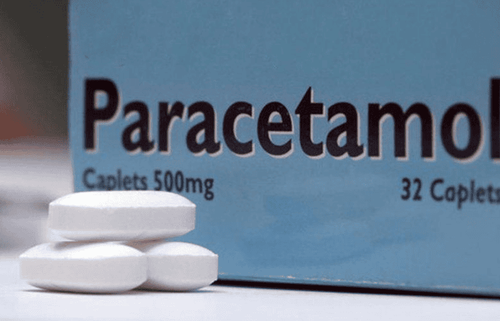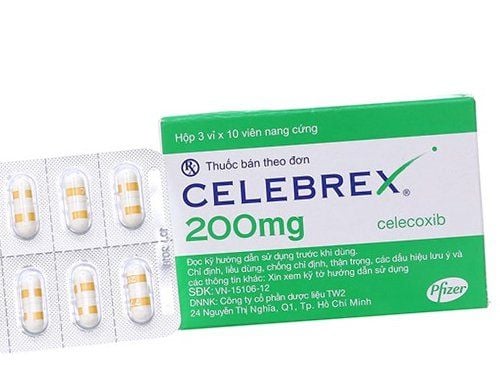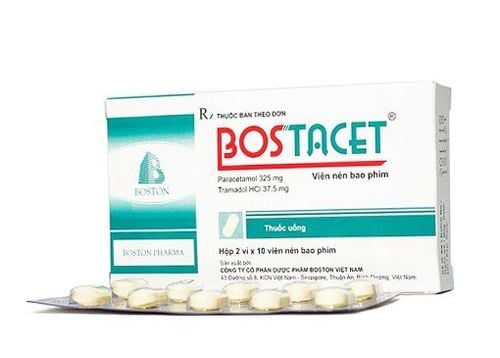This is an automatically translated article.
Bostacet drug with two main active ingredients Paracetamol and Tramadol, is an analgesic used in the treatment of moderate to severe pain. The following article provides you with some information about the uses of Bostacet as well as possible drug interactions during the use of Bostacet.
1. What is Bostacet?
Bostacet has two main active ingredients, Paracetamol with the content of 325mg and Tramadol hydrochloride with the content of 37.5mg, the drug is prepared with film-coated tablets.
Tramadol is a synthetic pain reliever that acts on the central nervous system. Tramadol and its active metabolite M1 act non-selectively on opioid receptors, with a higher affinity for muopioid receptors. In addition, Tramadol inhibits the reuptake of norepinephrine and serotonin, which contributes to the analgesic effect of the drug. Tramadol has a cough suppressant effect. Unlike morphine, with usual doses, Tramadol has no respiratory depression, intestinal motility changes, cardiovascular effects are negligible. The potency of Tramadol is only 1/10 - 1/6 of morphine.
Paracetamol is a synthetic analgesic and antipyretic and a derivative of p - aminophenol. Paracetamol's mechanism of action is antipyretic and analgesic, but does not have anti-inflammatory and antiplatelet effects like salicylic acid. Paracetamol acts on the hypothalamus to cause hypothermia, increased heat loss due to vasodilation and increased peripheral blood flow. Studies in laboratory animals have shown that the combination of Paracetamol and Tramadol has a synergistic effect.
2. Uses of Bostacet
2.1 What disease does Bostacet treat? Bostacet is indicated for the treatment of moderate to severe pain. Bostacet should be limited to the treatment of patients with severe pain requiring the use of a combination of Paracetamol and Tramadol.
2.2 Contraindications to using Bostacet Allergy, hypersensitivity to Paracetamol, Tramadol or any component of the drug or to opioids. Patients with acute poisoning due to alcohol, hypnotics, narcotics, CNS depressants, psychotropic drugs and opioid drugs. Ongoing treatment or stopping treatment with a monoamine oxidase inhibitor (MAOI) within 2 weeks. Severe liver failure. Seizures are not treated.
3. How to take Bostacet
Bostacet film-coated tablets are for oral use. Take Bostacet as a whole, do not break or chew the tablet. Dosage of Bostacet:
Adults, children over 12 years old:
The starting dose is 2 tablets / day, supplementing the dose when necessary but the maximum dose is 8 tablets / day. Maximum dose of Bostacet: 8 tablets/day (equivalent to 300mg Tramadol and 2600mg Paracetamol). The interval between doses should not be less than 6 hours.
Adjust patient dose of Bostacet according to pain intensity and individual response. The lowest effective dose of Bostacet should be used.
Bostacet should not be used for longer than necessary. If repeated use or prolonged treatment of Bostacet is required due to the nature and severity of the disease, caution should be exercised and regular monitoring is required.
Children under 12 years old:
There are currently no studies on the safety and effectiveness of using Bostacet in children under 12 years of age. Therefore, the drug Bostacet is not recommended for children under 12 years of age.
Elderly
No dose adjustment of Bostacet is required for adults over 75 years of age. Studies have shown that adults over 75 years of age experience a 17% increase in the half-life of Tramadol. Time interval between doses of Bostacet at least 6 hours,
4. Some notes when using Bostacet
Do not use Bostacet more than the indicated dose, the maximum dose is 8 tablets/day. Paracetamol overdose can cause liver toxicity.
Convulsions have been reported in Tramadol-treated patients with an increased risk of convulsions when co-administered with tricyclic antidepressants, selective serotonin reuptake inhibitors, CNS depressants, or CNS depressants. local analgesics, antipsychotics. Either the patient has a history of seizures or the patient is at risk for seizures. Not recommended for use in patients with severe renal impairment (creatinine clearance < 10 mL/min) and severe respiratory failure.
Bostacet is not recommended for patients with severe liver failure. The risk of paracetamol overdose is increased in patients with a history of alcoholic liver disease, cirrhosis. Consider increasing dosing intervals in patients with moderate hepatic impairment.
Concomitant use of Bostacet with morphine agonists or antagonists (Nalbuphin, Buprenorphine, Pentazocin), local anesthetics or anesthetics is not recommended.
Do not use Bostacet concurrently with drugs containing Paracetamol and Tramadol.
Avoid long-term drug use, especially in patients with a history of opioid addiction. Tramadol is not effective against morphine withdrawal symptoms.
Long-term use of Bostacet can cause familiarity or addiction to the drug, avoid taking the drug suddenly. Patients with a history of drug abuse or addiction or dependence on opioids should be given the drug for a short period of time under the guidance of a physician. Bostacet should be used with caution in patients with traumatic brain injury, increased intracranial pressure, in shock or unexplained changes in consciousness, disorders of the respiratory center or respiratory function.
Bostacet withdrawal symptoms can occur, either at therapeutic doses or during short-term treatment. Reducing the dose slowly during discontinuation helps to reduce the risk of withdrawal symptoms, especially after long-term use.
Physicians should warn patients about signs of serious skin reactions such as toxic skin necrosis syndrome (TEN), Stevens-Johnson syndrome (SJS), or acute generalized exanthematous pustulosis. (AGEP), Lyell's syndrome. Bostacet contains lactose, so it should not be used in patients with conditions such as lactase deficiency, galactose intolerance or glucose-galactose malabsorption.
Tramadol contained in the drug Bostacet can cause drowsiness, dizziness, cognitive impairment. In case of occurrence of the above side effects, the patient should not operate machinery or drive a vehicle.
5. Undesirable effects when using Bostacet
During the use of Bostacet, some of the following side effects may occur:
Digestion: dry mouth, nausea, vomiting, abdominal pain, flatulence, indigestion, constipation, black stools. Nervous system: dizziness, headache, somnolence, tremor, paresthesia, tinnitus, convulsions, fainting. Skin: sweating, itching. Less common: skin rash or urticaria. Psychiatric: sleep disturbances, confusion, mood swings, drug dependence.
6. Possible interactions of Bostacet
6.1 Interaction with Tramadol Drug combination is contraindicated: MAO (non-selective MAO inhibitor and selective MAO inhibitor A, B) when co-administered with Tramadol causes serotonin syndrome with symptoms such as heart rhythm rapidity, diarrhea, sweating, tremors, confusion, even coma. Discontinue use of MAOIs two weeks before using Tramadol.
Combination of drugs is not recommended Alcohol, alcoholic beverages: increase the sedative effect of Bostacet. Carbamazepine, an enzyme inducer that increases the metabolism of Tramadol, may decrease the effectiveness and duration of action of Bostacet.
Morphine agonists or antagonists: reduce the analgesic effect of Tramadol by competitive blocking of receptors with the risk of withdrawal syndrome.
Combination with caution when using selective serotonin reuptake inhibitors (SSRIs), serotonin-norepinephrine reuptake inhibitors (SNRIs), antipsychotics, tricyclic antidepressants: concomitant use with Tramadol may increases the risk of convulsions.
Serotonin drugs concurrently with Tramadol can cause serotonin toxicity. Other opioid derivatives, benzodiazepines, barbiturates increase the risk of respiratory depression and even death in overdose.
CNS depressants such as other opioid derivatives, benzodiazepines, barbiturates, anxiolytics, antidepressants, hypnotics, 1st generation H1 antihistamines, CNS-active antihypertensives , tranquilizers, thalidomide, baclofen increase the CNS depressant effect when used with Tramadol, may affect cognitive ability.
Concomitant use with drugs of the Warfarin group: conduct periodic evaluation of prothrombin time index. There have been reports of increased INR and risk of bleeding in some patients. CYP3A4 inhibitors such as erythromycin and ketoconazole inhibit the metabolism of tramadol.
6.3 Drug Interactions with Paracetamol Cholestyramine: reduces absorption of Paracetamol.
Domperidone, Metoclopramide: increased absorption of Paracetamol.
Anticoagulants: Warfarin's anticoagulant effect may be increased with regular use of Paracetamol.
Hopefully with the above sharing will help the process of using Bostacet drug more effectively and safely in patients.
Please dial HOTLINE for more information or register for an appointment HERE. Download MyVinmec app to make appointments faster and to manage your bookings easily.













